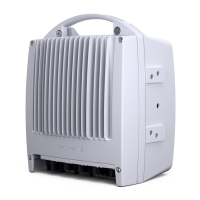MINI-LINKEandEMicro
Received Traffic Data
On the receiving side the following is performed to the traffic data:
• AIS insertion (at signal loss or BER ≤ 10
–3
)
• AIS detection
• Elastic buffering and clock recovery
• Data alignment compensation and measurement (to enable hitless
sw itching)
• Hitless switching (for 1+1 protection)
Received Service D ata Channel
In digital mode data and sync are retrieved and the clock rate is recovered
using an elastic buffer. In analog mode synchronization and timing signals are
provided together with the data signal.
3.8.2.6 Demodulator
The received 140 MHz signal is AGC amplified and filtered prior to conversion
to I/Q baseband signals. The baseband signals are pulse shaped in a Nyqvist
filter and A/D converted before being C-QPSK demodulated.
3.8.2.7 Cable Interface
The following signals are frequency multiplexed in the cable interface for further
distribution through a coaxial cable to the outdoor radio units:
• 350 MHz transmitting IF signal
• 140 MHz receiving IF signal
•DCpowersupply
• Radio Communication Channel (RCC) signal as an Amplitude Shift Keying
(ASK) signal
In addition to the above, the cable interface includes an overvoltage protection
circuit.
3.8.2.8 Control and Super vision
A microprocessor based control and super vision system (CSS) is built into all
units in the access module. Its m ain functions are t o collect alarms, control
settings and tests. Failure is indicated on LEDs on the fronts of the units.
The M MU processor com municates with other processors in the access m odule
through the NCC. Exchange of control and super vision data over the hop is
50
AE/LZT 110 2012 R8C 2002-03-04

